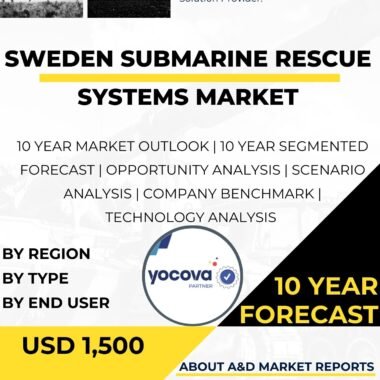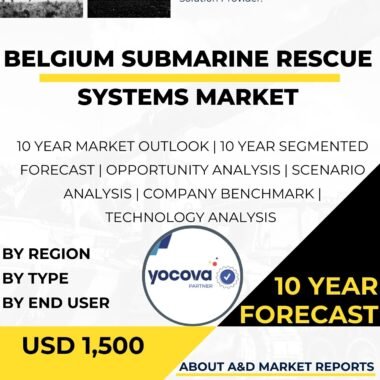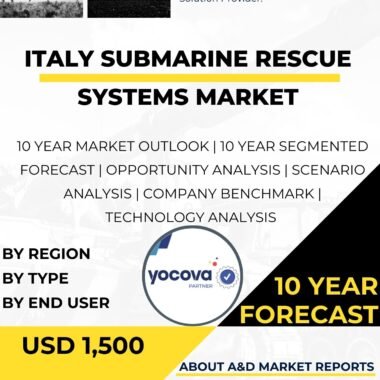Description
The Singapore submarine rescue systems market represents a critical aspect of the country’s maritime defense capabilities, providing essential assets and capabilities to respond to submarine emergencies and rescue submariners in distress. Submarine rescue systems are specialized equipment and procedures designed to locate and retrieve crew members from a disabled or stranded submarine. This article provides an overview of the Singapore submarine rescue systems market, including key features, applications, challenges, technological advancements, collaborations, and future prospects.
Submarine rescue systems are essential components of naval forces worldwide, ensuring the safety of submariners and maintaining operational readiness. These systems consist of submersible vehicles, rescue chambers, and associated equipment designed to deploy rapidly and reach a distressed submarine to conduct search and rescue operations.
The primary application of submarine rescue systems in Singapore is to support the operations of the Republic of Singapore Navy’s (RSN) submarine fleet. As a maritime nation with strategic interests in the region, Singapore relies on its submarine force to protect its territorial waters, secure sea lanes, and respond to potential security challenges. The presence of an efficient and effective submarine rescue capability is critical to mitigating risks associated with submarine operations.
Additionally, submarine rescue systems play a significant role in international cooperation and humanitarian assistance. Singapore’s submarine rescue assets can be deployed to support rescue operations in the region or during multinational exercises involving submarines from allied navies. Collaborative efforts in submarine rescue demonstrate the country’s commitment to regional security and disaster response.
The development and maintenance of submarine rescue systems present several challenges and opportunities for technological advancements.
One of the primary challenges lies in the complexity of submarine rescue operations. Responding to a submarine in distress requires quick and precise coordination, especially in adverse weather conditions or deep-sea environments. Integrating real-time communication and data-sharing capabilities into rescue systems is essential to enhance situational awareness and response efficiency.
Moreover, ensuring the compatibility and interoperability of submarine rescue systems with various submarine classes can be challenging. Different submarine designs and configurations may require tailored rescue procedures and equipment. Standardization efforts and collaboration with submarine manufacturers are vital to addressing these challenges.
Technological advancements are continuously being pursued to enhance the capabilities of submarine rescue systems. Research and development efforts focus on improving submersible vehicles’ endurance, range, and maneuverability to reach submarines faster and more efficiently. Additionally, advancements in deep-sea communication and sensor technologies enhance the accuracy of locating distressed submarines and monitoring rescue operations.
Singapore actively engages in collaborations and partnerships with other nations and organizations to strengthen its submarine rescue capabilities. The country participates in regional and international exercises and workshops focused on submarine rescue and disaster response.
Collaboration with other navies and defense organizations fosters knowledge exchange, standardization of procedures, and the establishment of regional submarine rescue networks. Singapore’s involvement in these initiatives demonstrates its commitment to contributing to global maritime safety and security.
The future prospects for the Singapore submarine rescue systems market are positive, driven by the country’s commitment to maritime defense modernization and international cooperation.
As submarine technology evolves, the Singaporean Navy may acquire new classes of submarines, requiring continuous updates to its submarine rescue assets. Investing in state-of-the-art rescue systems ensures that Singapore’s submarine fleet remains equipped with the latest rescue capabilities and can respond effectively to potential emergencies.
Moreover, the ongoing collaboration with international partners and participation in regional exercises and workshops will further enhance Singapore’s submarine rescue capabilities. Strengthening regional cooperation in submarine rescue enhances maritime security and response capabilities in the Asia-Pacific region.
The Singapore submarine rescue systems market is a critical component of the country’s maritime defense capabilities. Submarine rescue systems play a vital role in supporting the operations of the Republic of Singapore Navy’s submarine fleet and demonstrate the country’s commitment to regional security and international cooperation.
Challenges related to complex submarine rescue operations and technological advancements present opportunities for innovation and collaboration. Continuous research and development efforts are expected to improve the efficiency and capabilities of submarine rescue systems.
In conclusion, the Singapore submarine rescue systems market plays a vital role in ensuring the safety of submariners and maintaining the operational readiness of the country’s submarine fleet. The future prospects for the market remain positive, driven by Singapore’s commitment to defense modernization, international cooperation, and advancements in rescue technologies. Collaborative efforts in submarine rescue strengthen regional maritime security and disaster response capabilities in the Asia-Pacific region.”




